The Snapdragon 865 Performance Preview: Setting the Stage for Flagship Android 2020
by Andrei Frumusanu on December 16, 2019 7:30 AM EST- Posted in
- Mobile
- Qualcomm
- Smartphones
- 5G
- Cortex A77
- Snapdragon 865
Machine Learning Inference Performance
AIMark 3
AIMark makes use of various vendor SDKs to implement the benchmarks. This means that the end-results really aren’t a proper apples-to-apples comparison, however it represents an approach that actually will be used by some vendors in their in-house applications or even some rare third-party app.

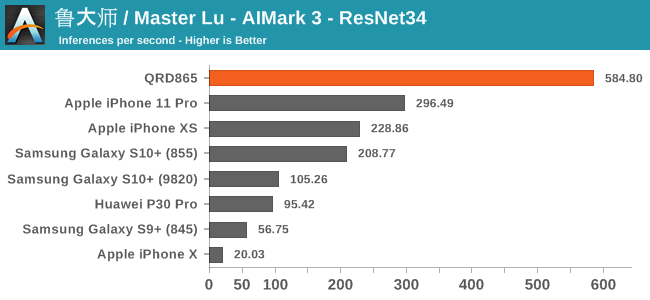
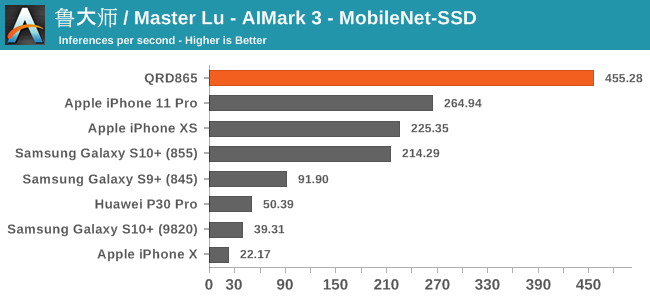
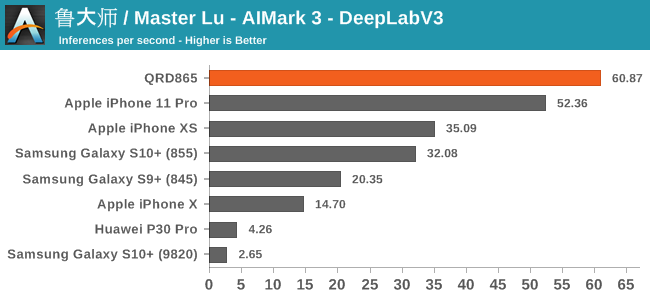
In AIMark 3, the benchmark uses each vendor’s proprietary SDK in order to accelerate the NN workloads most optimally. For Qualcomm’s devices, this means that seemingly the benchmark is also able to take advantage of the new Tensor cores. Here, the performance improvements of the new Snapdragon 865 chip is outstanding, posting in 2-3x performance compared to its predecessor.
AIBenchmark 3
AIBenchmark takes a different approach to benchmarking. Here the test uses the hardware agnostic NNAPI in order to accelerate inferencing, meaning it doesn’t use any proprietary aspects of a given hardware except for the drivers that actually enable the abstraction between software and hardware. This approach is more apples-to-apples, but also means that we can’t do cross-platform comparisons, like testing iPhones.
We’re publishing one-shot inference times. The difference here to sustained performance inference times is that these figures have more timing overhead on the part of the software stack from initialising the test to actually executing the computation.
AIBenchmark 3 - NNAPI CPU
We’re segregating the AIBenchmark scores by execution block, starting off with the regular CPU workloads that simply use TensorFlow libraries and do not attempt to run on specialized hardware blocks.
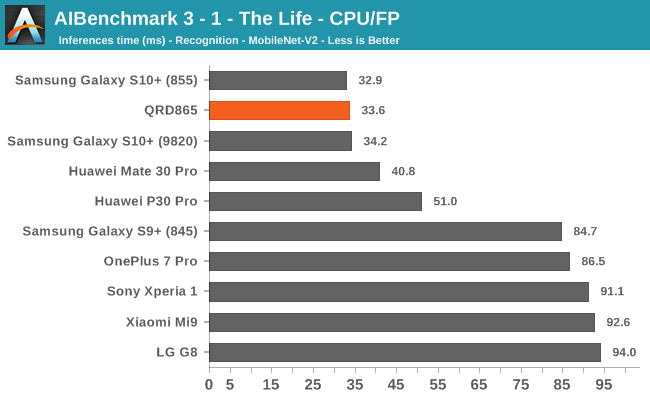
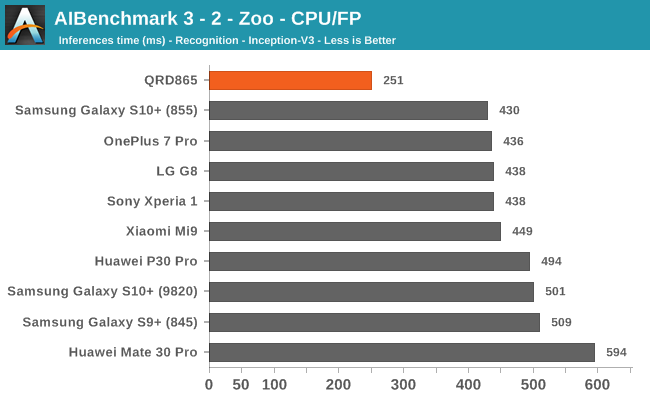

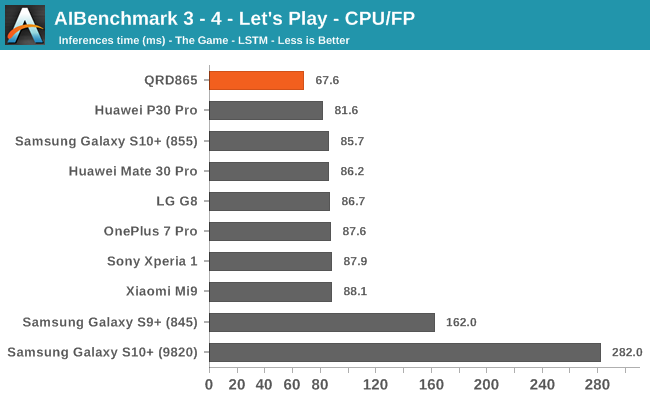

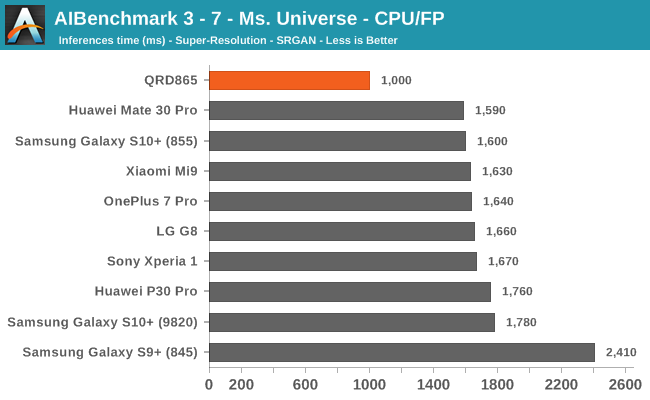

Starting off with the CPU accelerated benchmarks, we’re seeing some large improvements of the Snapdragon 865. It’s particularly the FP workloads that are seeing some big performance increases, and it seems these improvements are likely linked to the microarchitectural improvements of the A77.
AIBenchmark 3 - NNAPI INT8
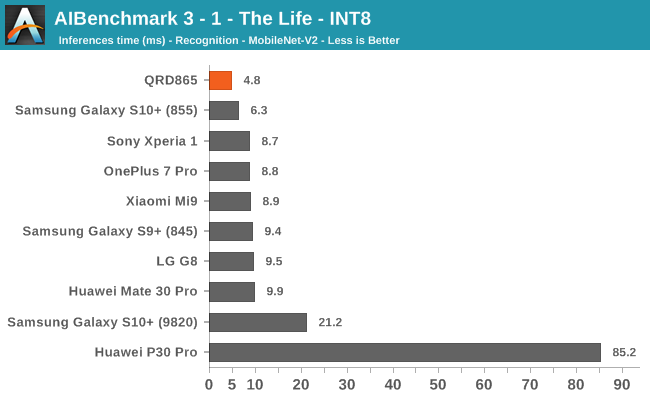
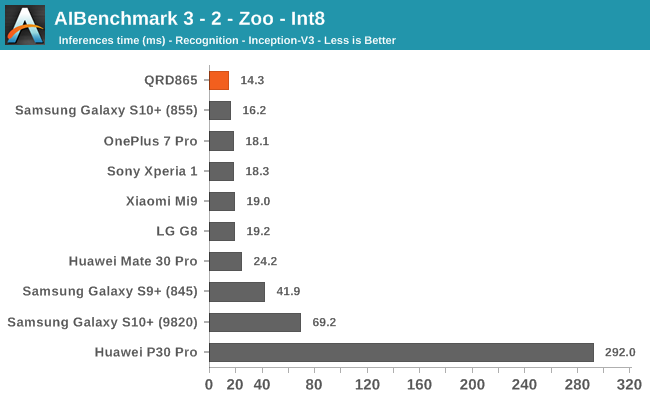
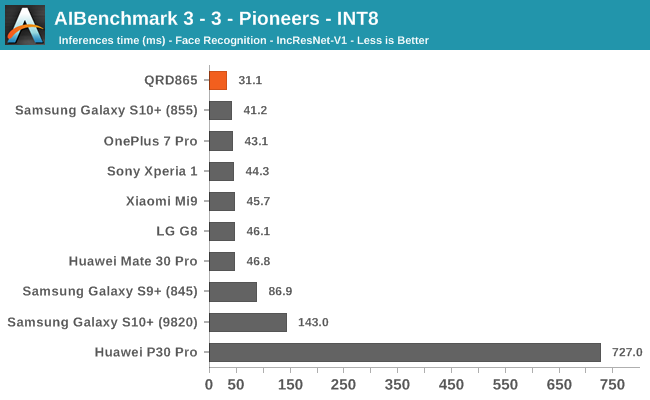
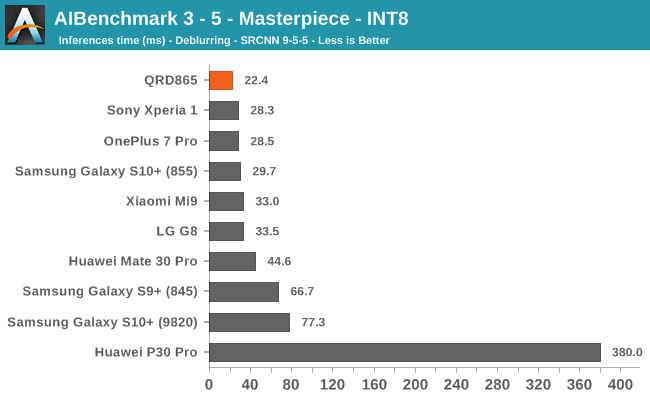
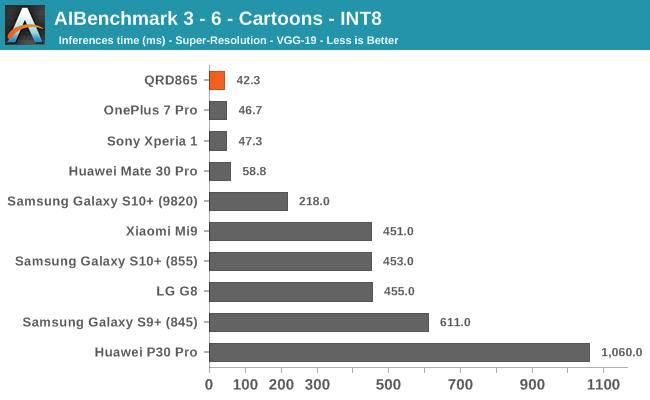
INT8 workload acceleration in AI Benchmark happens on the HVX cores of the DSP rather than the Tensor cores, for which the benchmark currently doesn’t have support for. The performance increases here are relatively in line with what we expect in terms of iterative clock frequency increases of the IP block.
AIBenchmark 3 - NNAPI FP16
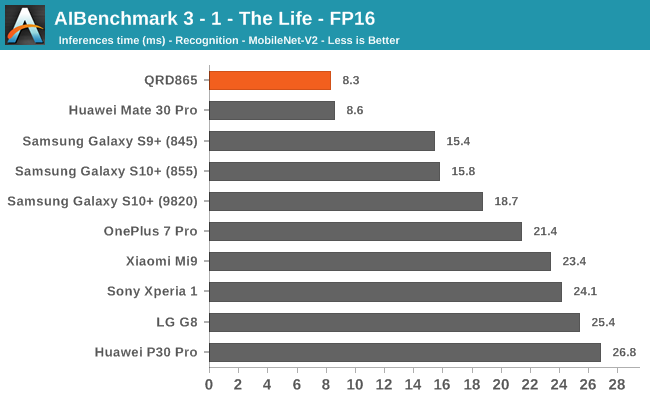
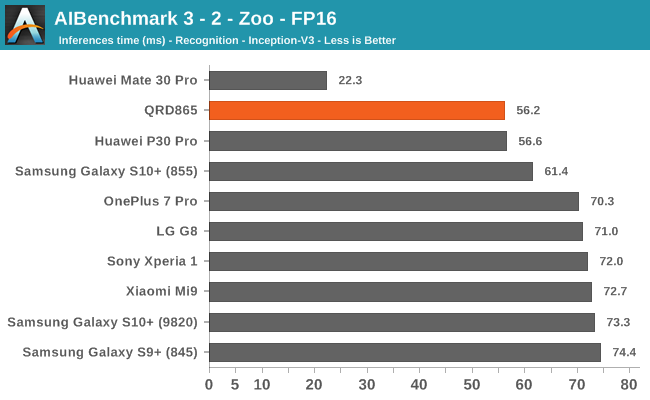
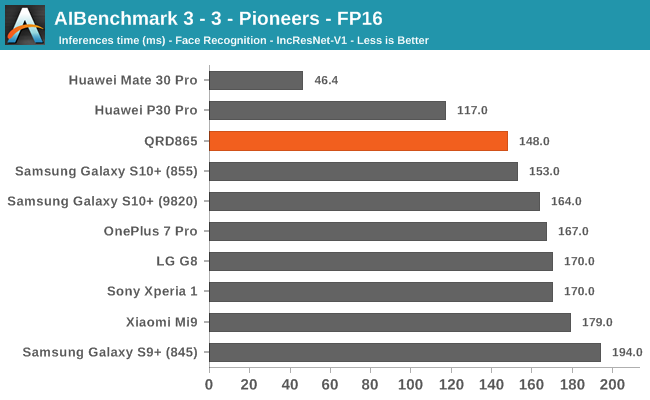
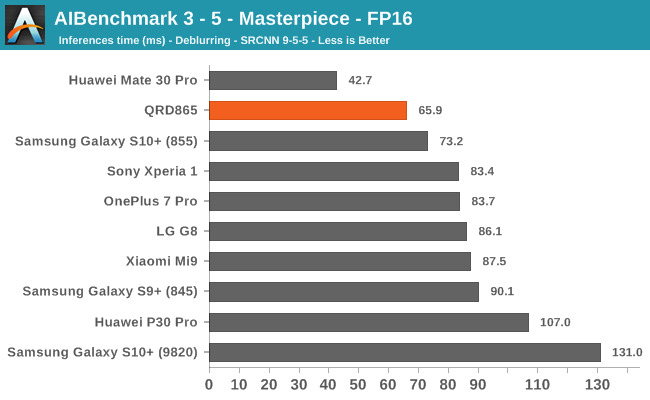
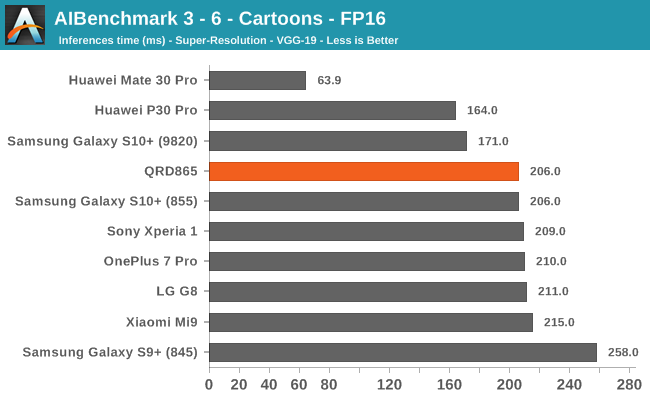
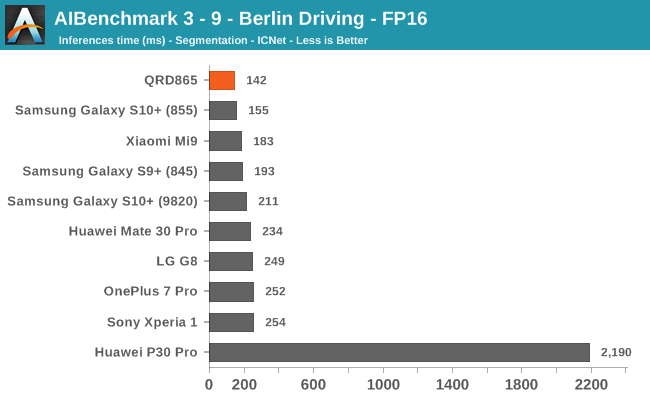
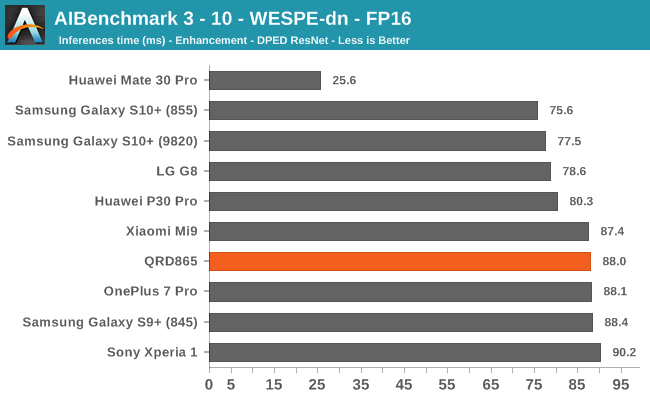
FP16 acceleration on the Snapdragon 865 through NNAPI is likely facilitated through the GPU, and we’re seeing iterative improvements in the scores. Huawei’s Mate 30 Pro is in the lead in the vast majority of the tests as it’s able to make use of its NPU which support FP16 acceleration, and its performance here is quite significantly ahead of the Qualcomm chipsets.
AIBenchmark 3 - NNAPI FP32
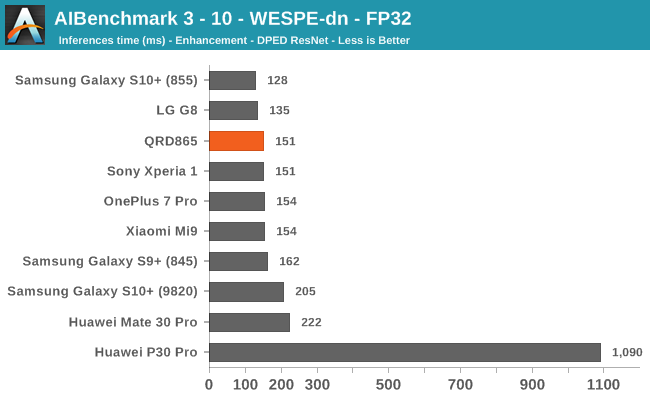
Finally, the FP32 test should be accelerated by the GPU. Oddly enough here the QRD865 doesn’t fare as well as some of the best S855 devices. It’s to be noted that the results here today were based on an early software stack for the S865 – it’s possible and even very likely that things will improve over the coming months, and the results will be different on commercial devices.
Overall, there’s again a conundrum for us in regards to AI benchmarks today, the tests need to be continuously developed in order to properly support the hardware. The test currently doesn’t make use of the Tensor cores of the Snapdragon 865, so it’s not able to showcase one of the biggest areas of improvement for the chipset. In that sense, benchmarks don’t really mean very much, and the true power of the chipset will only be exhibited by first-party applications such as the camera apps, of the upcoming Snapdragon 865 devices.










178 Comments
View All Comments
gagegfg - Monday, December 16, 2019 - link
Qualcomm works for Android, so Apple's competition doesn't generate much trouble, just embarrassment. It seems that the second does not motivate them much haha.Drumsticks - Monday, December 16, 2019 - link
This comment might be too late to be seen, but is there any chance we can see the power use for the Zen 2/SKL (ICL?) based devices on the spec charts as well? It might be off by a lot, but I'm curious how they compare to the mobile SoCs. If they're too high because they're desktop chips intended for higher TDPs where maximum efficiency isn't needed, maybe it's worth it to throw in an Icelake-U number as well as a Zen 2 mobile chip when they come in.Andrei Frumusanu - Monday, December 16, 2019 - link
We never measured it accurately, the corresponding platform power for those desktop chips is generally going to be in the 30-40W range or even higher. The laptop platforms are also going to be in the 10-15W range.Drumsticks - Monday, December 16, 2019 - link
Fair enough; thanks for the reply! There is an awful lot more platform related stuff that isn't optimized on DT, I kind of derped on that.Thanks for your work on the article, too. I really enjoy your writeups and sympathize with the author who stays as engaged as you do with *every* commenter.
TEAMSWITCHER - Monday, December 16, 2019 - link
The ads on this site are obnoxious.TheinsanegamerN - Tuesday, December 17, 2019 - link
-Not using an adblocker in 2019....GH-CC - Monday, December 16, 2019 - link
I'm not engineer, not much knowlege but one part in this article really concerns me:"Generally, we’ve noted that there’s a discrepancy factor of roughly 3x. We’ve reached out to Qualcomm and they confirmed in a very quick testing that there’s a discrepancy of >2.5x. Furthermore, the QRD865 phones this year again suffered from excessive idle power figures of >1.3W."
Does this mean compared to SD855, SD865 consume more power when idling?
Also, was this test conducted with internet connection or not?
Andrei Frumusanu - Monday, December 16, 2019 - link
The above quote is only valid for the QRD865; similar thing happened to the QRD855 test devices. It's not a concern for final commercial devices, so nothing to worry about.assyn - Monday, December 16, 2019 - link
Seems like Apple is basically untouchable.Evben an old A11 humiliating the top Android soc..:D
joms_us - Monday, December 16, 2019 - link
Humiliating by what? Some imaginary worthless bloated benchmark scores from a primitive tool that doesn't translate to real-world? For the last 2 years Apple is the one catching up in any side-by-side comparisons out there.